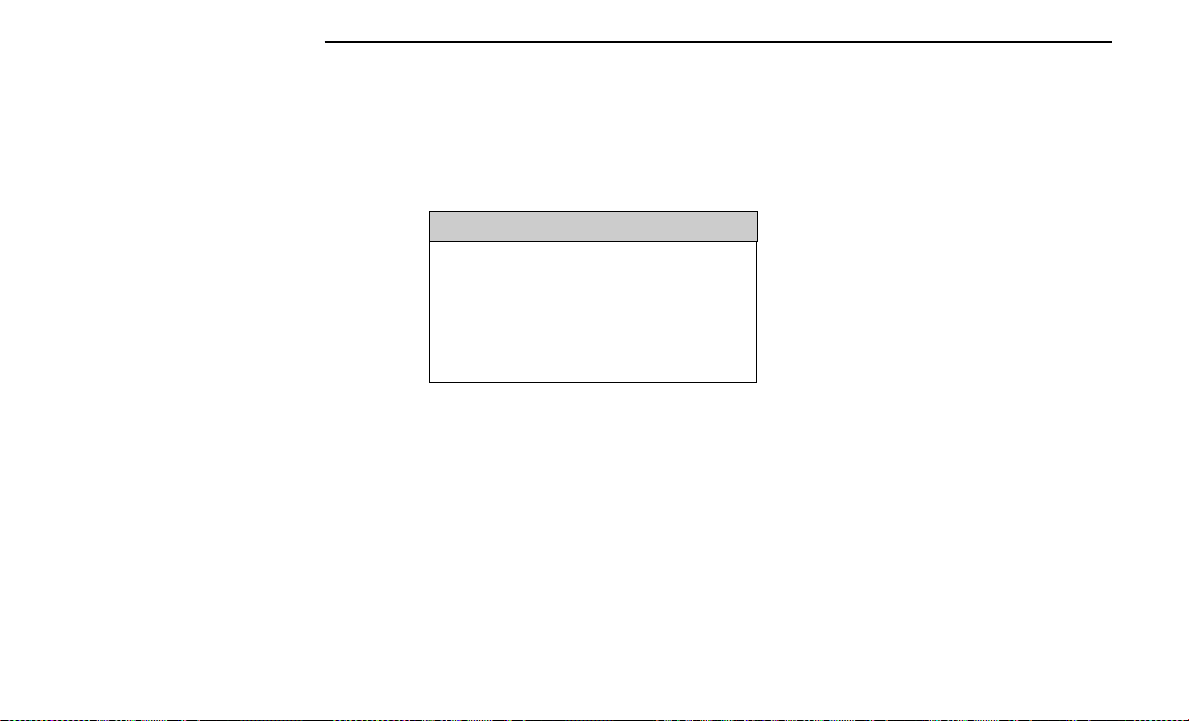Loading ...
Loading ...
Loading ...

Tongue Weight (TW)
The TW is the downward force exerted on the hitch ball
by the trailer. You must consider this as part of the load
on your vehicle.
Trailer Frontal Area
The frontal area is the maximum height multiplied by
the maximum width of the front of a trailer.
Trailer Sway Control (TSC)
The TSC can be a mechanical telescoping link that can
be installed between the hitch receiver and the trailer
tongue that typically provides adjustable friction associ-
ated with the telescoping motion to dampen any
unwanted trailer swaying motions while traveling.
If equipped, the electronic TSC recognizes a swaying
trailer and automatically applies individual wheel
brakes and/or reduces engine power to attempt to
eliminate the trailer sway.
Weight-Carrying Hitch
A weight-carrying hitch supports the trailer tongue
weight, just as if it were luggage located at a hitch ball
or some other connecting point of the vehicle. These
kinds of hitches are used to tow small and medium
sized trailers.
Weight-Distributing Hitch
A Weight-Distributing Hitch system works by applying
leverage through spring (load) bars. They are typically
used for heavier loads to distribute trailer tongue weight
to the tow vehicle's front axle and the trailer axle(s).
When used in accordance with the manufacturer's
directions, it provides for a more level ride, offering
more consistent steering and brake control thereby
enhancing towing safety. The addition of a friction/
hydraulic sway control also dampens sway caused by
traffic and crosswinds and contributes positively to tow
vehicle and trailer stability. Trailer sway control and a
weight-distributing (load equalizing) hitch are recom-
mended for heavier Tongue Weights (TW) and may be
required depending on vehicle and trailer
configuration/loading to comply with Gross Axle Weight
Rating (GAWR) requirements.
WARNING!
•
An improperly adjusted Weight-Distributing Hitch
system may reduce handling, stability, braking per-
formance, and could result in a collision.
•
Weight-Distributing Hitch systems may not be com-
patible with surge brake couplers. Consult with
your hitch and trailer manufacturer or a reputable
Recreational Vehicle dealer for additional
information.
RECOMMENDED DISTRIBUTION HITCH
ADJUSTMENT — QUADRA -LIFT AIR
SUSPENSION EQUIPPED VEHICLES
1. Verify that the vehicle is at the Normal Ride Height.
NOTE:
The vehicle must remain in the RUN position with all
doors closed while attaching a trailer for proper lev-
eling of the air suspension system.
2. Position the vehicle on a level surface in preparation
to connect to the trailer (do not connect the trailer).
3. For vehicles equipped with Quadra-Lift air suspen-
sion, use the touchscreen radio settings to enable
Tire/Jack mode. Tire/Jack mode will be canceled
and the procedure must be restarted if the vehicle
is driven at speeds above 5 mph (8 km/h). When
towing, the automatic Entry/Exit feature may be dis-
abled through the Uconnect Touchscreen Radio to
prevent vehicle and trailer movement when gear
selector is moved to PARK.
4. Measure the height from the top of the front wheel
opening on the fender to the ground; this is height
H1.
5. Attach the loaded trailer to the vehicle without the
weight distribution bars connected.
6. Measure the height from the top of the front wheel
opening on the fender to the ground; this is height
H2.
7. Install and adjust the tension in the weight-
distributing bars per the manufacturers’ recommen-
dations so that the height of the front fender is
approximately (H2-H1)/2+H1 (about 1/2 the differ-
ence between H2 and H1 above Normal Ride Height
[H1]).
Measuring Height (H)
168 STARTING AND OPERATING
Loading ...
Loading ...
Loading ...